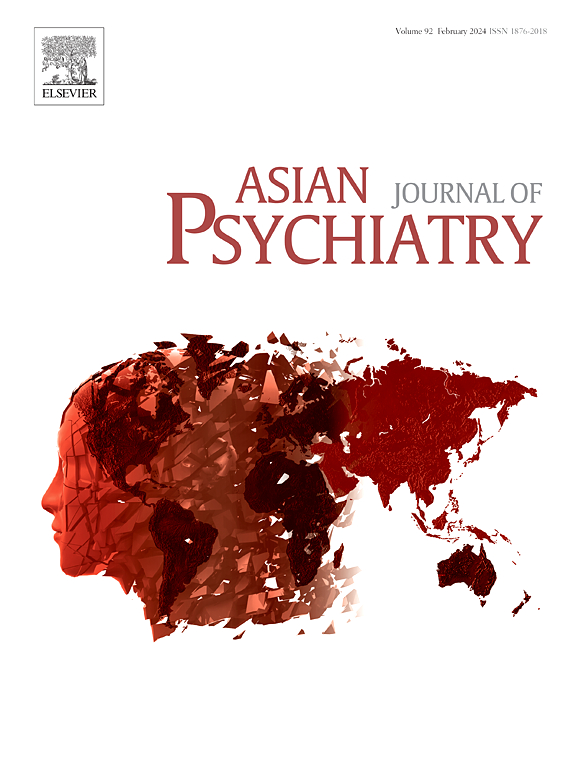An interpretable deep-learning approach to detect biomarkers in anxious-depressed symptoms from prefrontal fNIRS signals during an autobiographical memory test
IF 3.8
4区 医学
Q1 PSYCHIATRY
引用次数: 0
Abstract
Background
Individuals with anxious-depressed (AD) symptoms have more severe mood disorders and cognitive impairment than those with non-anxious depression (NAD) symptoms. Therefore, it is important to clarify the underlying neurophysiology of these two symptom groups to optimize treatment.
Methods
We developed an interpretable deep-learning framework based on two convolutional neural networks (CNN) to diagnose depression from functional near-infrared spectroscopy (fNIRS) neuroimaging data recorded during an autobiographical memory test (AMT) from 824 participants. This system was designed to discriminate between individuals with depressed symptoms (N = 127) and healthy controls (N = 697) and identify AD (N = 72) and NAD (N = 55). Besides, we employed the SHapley Additive exPlanations (SHAP) method to discover discriminative biomarkers for AD symptoms.
Results
Positive episode recall features effectively distinguished depressed symptoms with the highest accuracy of 0.89, sensitivity of 0.84, specificity of 0.90, and area under the receiver operator characteristic curve (AUC) of 0.84. Conversely, negative episode recall features achieved the highest accuracy of 0.91, sensitivity of 0.80, specificity of 0.85, and an AUC of 0.91 for identifying AD symptoms. These performances were based on a five-fold cross-validation procedure. Based on the SHAP-derived analyses, the most influential channels contributing to AD symptom prediction were located within the right hemisphere.
Conclusion
This study revealed that the hemodynamic hypo-activation of negative emotional valence in the right frontal pole area (rFPA) may contribute to AD symptom prediction.
一种可解释的深度学习方法在自传体记忆测试中通过前额叶fNIRS信号检测焦虑抑郁症状中的生物标志物
背景:有焦虑抑郁(AD)症状的个体比无焦虑抑郁(NAD)症状的个体有更严重的情绪障碍和认知障碍。因此,明确这两种症状组的潜在神经生理学以优化治疗是很重要的。方法基于两个卷积神经网络(CNN)开发了一个可解释的深度学习框架,从824名参与者在自传式记忆测试(AMT)中记录的功能近红外光谱(fNIRS)神经成像数据中诊断抑郁症。该系统旨在区分抑郁症状个体(N = 127)和健康对照(N = 697),并识别AD (N = 72)和NAD (N = 55)。此外,我们采用SHapley加性解释(SHAP)方法发现AD症状的鉴别生物标志物。结果阳性事件回忆特征能有效区分抑郁症状,准确率为0.89,灵敏度为0.84,特异性为0.90,受试者操作者特征曲线下面积(AUC)为0.84。相反,阴性事件回忆特征在识别AD症状方面的准确率最高,为0.91,灵敏度为0.80,特异性为0.85,AUC为0.91。这些性能是基于五重交叉验证程序。基于shap衍生的分析,对阿尔茨海默病症状预测最有影响的通道位于右半球。结论右额极区负性情绪效价血流动力学低激活可能与阿尔茨海默病的症状预测有关。
本文章由计算机程序翻译,如有差异,请以英文原文为准。
求助全文
约1分钟内获得全文
求助全文
来源期刊

Asian journal of psychiatry
Medicine-Psychiatry and Mental Health
CiteScore
12.70
自引率
5.30%
发文量
297
审稿时长
35 days
期刊介绍:
The Asian Journal of Psychiatry serves as a comprehensive resource for psychiatrists, mental health clinicians, neurologists, physicians, mental health students, and policymakers. Its goal is to facilitate the exchange of research findings and clinical practices between Asia and the global community. The journal focuses on psychiatric research relevant to Asia, covering preclinical, clinical, service system, and policy development topics. It also highlights the socio-cultural diversity of the region in relation to mental health.
 求助内容:
求助内容: 应助结果提醒方式:
应助结果提醒方式:


